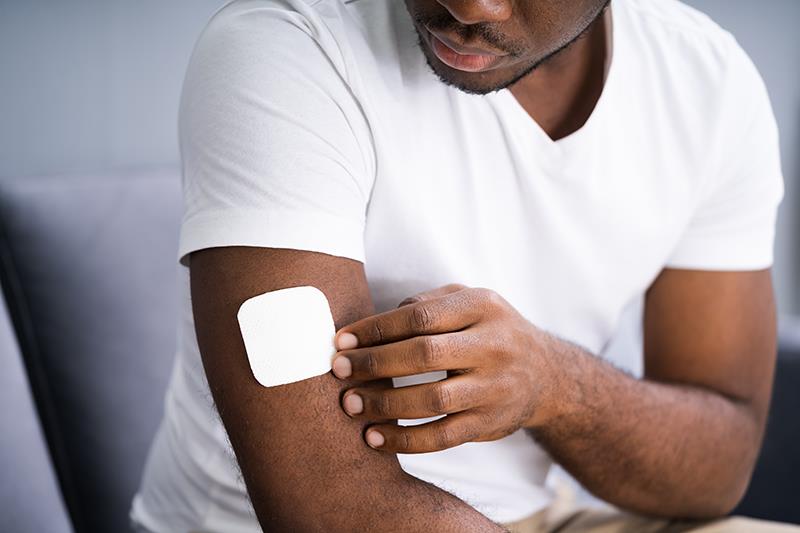LHRH analogues vs tE2 patches: Which work best in men with locally advanced prostate cancer?





The use of transdermal oestradiol (tE2) or oestrogen patches helps suppress testosterone and prostate-specific antigen (PSA) in men with locally advanced prostate cancer, with similar efficacy to that of luteinizing hormone-releasing hormone (LHRH) analogues, reports a study presented at EAU 2025.
In addition, “hot flushes were reduced substantially, although gynaecomastia increased,” said lead author Dr Duncan Gilbert from the University College London, MRC Clinical Trials Unit – Institute of Clinical Trials and Methodology, London, UK.
In this open-label, randomized phase III trial, Gilbert and his team compared tE2 with LHRH analogues in patients with histologically confirmed, newly diagnosed high-risk nonmetastatic (M0) prostate cancer or those relapsing with PSA ≥4 ng/ml and doubling in <6 months.
A total of 1,360 men, recruited between 2007 and 2022, were randomly allocated in a 1:1 ratio to receive either LHRH analogue depot (n=639) or tE2 100 mcg/24 h patches (n=721), changed twice weekly for >2 years. Prostate radiotherapy and docetaxel were permitted as indicated.
The investigators evaluated the following outcomes: castration rates (testosterone <1.7 nmol/L), PSA response (PSA <0.2 ng/ml: patients alive at 6 months with PSA <0.2 ng/ml, PSA 50: >50-percent, PSA 90: >90-percent reduction), toxicities, and long-term outcomes. They also assessed the metastasis-free survival (MFS), overall survival (OS), cause of death, and second malignancy rates.
Baseline characteristics were comparable between the two treatment arms. Of the participants, 68 percent planned to receive prostate radiotherapy (70 percent in the LHRH analogue arm and 67 percent in the tE2 arm) and 6 percent docetaxel (LHRH analogue: 7 percent; tE2: 5 percent).
Comparable results
The proportion of patients in the LHRH analogue and tE2 arms who achieved testosterone <1.7 nmol/L was 60 percent vs 82 percent at 1 month, 92 percent vs 93 percent at 3 months, and 97 percent vs 94 percent at 12 months, respectively. [EAU 2025, abstract A0474]
Similar rates were also noted in the proportion of those achieving PSA <0.2 ng/ml (27 percent vs 23 percent), PSA 50 (99 percent vs 99 percent), and PSA 90 (90 percent vs 85 percent).
Moderate to severe hot flushes occurred in 37 percent of men in the LHRH analogue arm compared with 7 percent of those in the tE2 arm. On the other hand, the incidence of symptomatic gynaecomastia events was lower with LHRH analogues (9 percent vs 38 percent), while significant fatigue was higher (25 percent vs 16 percent).
The MFS hazard ratio (HR) was 0.96 (95 percent confidence interval [CI], 0.81–1.14), in favour of tE2, excluding a 2-percent reduction in MFS. The OS rate was also better with tE2, with an HR of 0.89 (95 percent CI, 0.74–1.07).
Other outcomes, such as prostate cancer-related deaths (41 percent with LHRH analogue vs 46 percent with tE2), cardiovascular events (10 percent vs 7 percent), and second malignancy (14 percent vs 11 percent), did not significantly differ between the treatment arms.
“In conclusion, tE2 produces comparable rates of androgen deprivation therapy (ADT), PSA response, and long-term oncological outcomes in men commencing ADT with locally advanced prostate cancer,” Gilbert said.
“ADT is central to high-risk M0 prostate cancer management. LHRH analogues are a current standard of care with side effects attributable to loss of both testosterone and oestrogen,” the investigators said. “TE2 patches are an alternative ADT avoiding the cardiovascular toxicity of oral oestrogens, while maintaining bone mineral density, improving metabolic outcomes, and quality of life.”